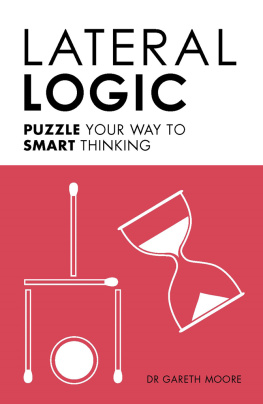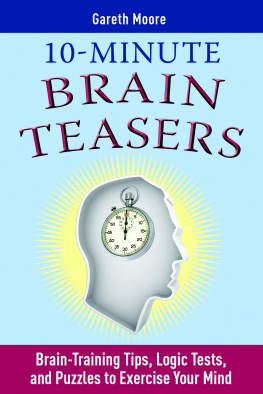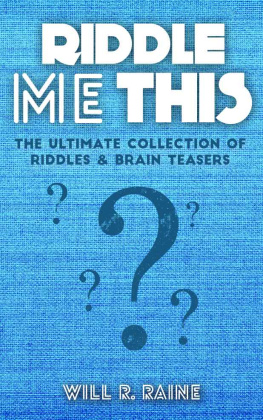Dr Gareth Moore is the creator of daily brain-training site BrainedUp.com, and author of a wide range of brain-training and puzzle books for both children and adults, including both Anti-Stress Puzzles and The Brain Workout.
He gained his Ph.D at the University of Cambridge, where he worked on machine intelligence.
First published in Great Britain in 2016 by
Michael OMara Books Limited
9 Lion Yard
Tremadoc Road
London SW4 7NQ
Copyright Michael OMara Books Limited 2016
Puzzles and solutions copyright Gareth Moore 2016
All rights reserved. No part of this publication may be reproduced, stored in a retrieval system, or transmitted by any means, without the prior permission in writing of the publisher, nor be otherwise circulated in any form of binding or cover other than that in which it is published and without a similar condition including this condition being imposed on the subsequent purchaser.
A CIP catalogue record for this book is available from the British Library.
ISBN: 978-1-78243-579-2 in paperback format
ISBN: 978-1-78243-689-8 in ebook format
www.mombooks.com
www.drgarethmoore.com
Typeset and designed by Gareth Moore
Welcome to Lateral Logic! By the time youve worked your way to the end, youll have proven yourself a master of both creative thinking and abstract thought!
Puzzle contents
The tasks in this book are broken into three difficulties: beginner, experienced and expert. Even if youre familiar with lateral-thinking puzzles, its best to start at the beginning and work your way through because many of the questions build on one another as the book progresses. If you jump straight to the end then youll risk spoiling the solution to a few of the earlier tasks.
Puzzles on the same page are usually related, either in terms of topic or by forming a series of progressive challenges. As with the book in general, its best to start with the first puzzle on a page before trying the second, so as not to spoil the answer to the preceding puzzle.
Some of the tasks in this book are designed to help you build your lateral-thinking skills by providing carefully constrained creative challenges. These will aid in unlocking creative abilities innate to all of us that you might not have realized you have!
Hints and solutions
Youll find both a Hints section and a Solutions section following each puzzle. You shouldnt be shy about reading the Hints if you get stuck on a puzzle, but start with the first hint, if there is more than one, and then return to the puzzle for a bit before you read the second or subsequent hints. The hints are arranged in order of revelation, from least to most, so the more hints you read then the easier the puzzle will become.
Full solutions are given for every puzzle, but if you arent sure if you have the expected solution then its a good idea to read the hints first, even if you dont think you need them, to see if your solution seems to match up. In this way you wont be spoiled for the given solution if youve managed to come up with another answer.
For some lateral-thinking puzzles there may be other reasonable solutions, but its worth remembering that what youre really looking for in most cases is the simplest, most sensible solution to a puzzle. Its often possible to come up with bizarre and unlikely solutions, so the skill is in finding a clean and realistic answer in each case. Its up to your own judgement as to whether any alternative answer you might find lives up to those criteria.
There are also some puzzles in this book which have specific, unique answers. It will always be clear from the text when you reach this type of task, so in these cases the answer given is the only correct solution.
How to solve lateral-thinking puzzles
Lateral-thinking puzzles typically require you to think about options which are not specifically given in the question. A classic example involves a hypothetical situation where there are three light bulbs in one room and three switches in another. You are told that each light switch operates a different one of the three bulbs, but what you dont know is which switch is which. All of the bulbs are switched off, and you cant see the room with the bulbs from the room where the switches are. The problem is to work out which switch controls which bulb, without entering either room more than once. You are on your own in the rooms, so you cant just call out to someone else to see which bulb is affected by which switch.
If you were able to go in and out of each room twice, the problem would be simple. You would enter the room with the switches, turn on one switch, go to the room with the bulbs and make a note of which bulb had illuminated. Youd then return to the switch room and turn on a second switch, before returning again to the room with the lights and seeing which bulb had come on the second time. Clearly, the third switch would then control the third bulb, and the problem would be solved.
You only have a single visit to the switch room, so you must do something else to allow you to identify which bulb each of the three switches controls. To solve the puzzle, its best to start by thinking through all of the possibilities, which seem to be:
1) Turn on no switches
2) Turn on one switch
3) Turn on two switches
4) Turn on all three switches
Option 1 wont help, since you will clearly learn nothing. Option 2 will identify one switch-bulb pair, but leave you with a 50:50 guess for the other two. Similarly, option 3 will identify the off bulb as corresponding to one of the switches, but again leave you with a 50:50 guess for the remaining two switches. Option 4 is no better than option 1.
In an ordinary type of puzzle, one of the four options above would be the answer, because in a non-lateral-thinking puzzle you tend to have all the possible parameters explicitly given to you in the question. In this case, however, you need to think of options which are not explicitly given to you. Once you do this, of course, there are often many different potential solutions, as discussed above, but what youre always looking for is the easiest and most reasonable solution.
In this particular puzzle, if the question hadnt mentioned that you were on your own then an easy solution would simply have been to have a second person in the bulb room, and to call out to them as you toggle each switch on and off. That person wouldnt have been explicitly mentioned in the question, but you would have thought laterally about how you would be able to solve the puzzle using more than just the information and ideas directly given to you in the question.
You might also come up with a complex way of solving this puzzle, such as perhaps installing a video camera in the bulb room and then turning on the three switches one at a time, followed by watching the video recording back to see which bulb came on in which order. Thats a perfectly reasonable solution, although its more complex than the solution given below so subjectively its not quite as good. Another reasonable but more complex solution would be to install a series of mirrors so that you can see from one room to the other. Short of adding a huge number of conditions to every lateral-thinking question, its rarely possible to exclude all other potential answers.
Having exhausted options with the switches, what this puzzle now requires you to do is to think about the bulbs instead of the switches. To give you a hint, if you are now told that the solution does not involve any additional equipment, but does require you being able to reach the bulbs, can you make any progress?
Next page













